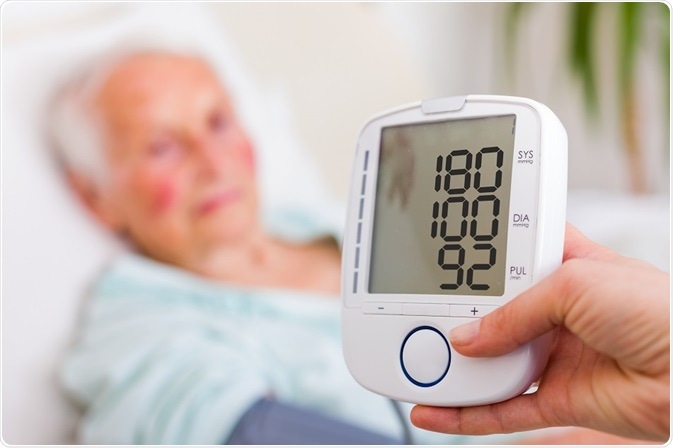By Jeyashree Sundaram, MBA
High blood pressure (BP) has reached epidemic proportions among the population worldwide. In the USA alone, 1 of every 3 adults is hypertensive, and another 1 out of 3 is pre-hypertensive. Researchers working on the causes of high blood pressure concur that bisphenol A is a major contributing factor to this state of affairs.

Credit: Lighthunter/ Shutterstock.com
(BPA) is a chemical that is used to make a wide range of products such as water bottles, food containers, contact lenses, and even dental fillings. New studies show that BPA from plastic bottles leaches into the food products contained within and raises the blood pressure within a few hours. Study findings also reveal that even a single exposure to consumption of canned beverages/food can impact the cardiovascular health of a person.
The European Chemicals Agency has termed BPA a chemical of high concern and a major endocrine disrupter.
Blood pressure and urine output
There is a direct relationship between urine output and high BP: a hypertensive patient has increased urine output.
Several studies using urinary BPA measurement have shown a positive association between serum BPA and hypertension. This association remained relatively constant across age, sex, BMI, or diabetic levels.
It has been observed that after drinking from a can, a person shows increased levels of BPA in urine after 2 hours, whereas the same amount of beverage consumed from a glass bottle does not reflect in an increase in BPA in urine.
BPA and increased blood pressure
Studies report a direct link between the concentration of BPA and blood pressure. A 5-point increase in BP is seen following BPA exposure, which could be quite a significant percentage for those who are already hypertensive.
Nevertheless, studies do not mention the onset of chronic hypertension due to repeated BPA exposures. Further longitudinal studies are required to clarify this aspect
Drinking canned beverages
BPA is widely used in making plastic bottles and the inner coating of beverage cans. Experiments show that systolic blood pressure increases by ≈4.5 mm Hg after consumption of two canned beverages (soft drinks or soups) compared with no change after consumption of the same two beverages from glass bottles.
BPA levels after canned soymilk: Soymilk from cans was used in some experiments because it has no ingredients that can cause a rise in BP. Experimental results showed that the urine of persons who drank soymilk from cans showed substantial increase in BPA levels, compared with those who drank from bottles made of glass.
After consuming just two soymilk servings from cans, people showed a 5mm Hg increase in their systolic blood pressure, in contrast to no change in those who consumed two servings from a glass bottle.
Effects of BPA on the cardiovascular system
Although the exact mechanism of action of BPA on the cardiac system is not very clear, a number of pathways are possible. Human exposure to BPA is mainly via oral means.
An association of BPA with all criteria for hypertension has been observed, but the connection was weak for high systolic BP and high diastolic BP.
BPA exposure affects the mechanism of insulin secretion and results in weight gain leading to obesity which is an established factor in hypertension.
BPA can bind to thyroid hormone receptors. It influences the actions of free thyroid hormone by causing a decrease in its level.
Estrogen is important for endothelial regulation. Estrogen receptors play a vital function in the repair of blood vessels and in the control of blood pressure. BPA is said to be a xenoestrogen that mimics the function of estrogen in the body. This disrupts the estrogen levels in the body as well as estrogen action on its receptors. Postmenopausal women have shown greater effects due to BPA on their blood pressure.
Long-term exposure to BPA even at low levels can affect the biological functioning of the circulatory system and can lead to circulatory issues such as arrhythmias, cardiac remodeling, atherosclerosis and hypertension. These issues are caused by alterations in the underlying molecular mechanisms such as rapid signaling of estrogen receptors, modification of cardiac calcium channels by phosphorylation of proteins involved in the mobilization of calcium, and oxidative stress.
BPA is a potential toxin to the cardiac cells and generates reactive oxygen species by increased oxidative degradation of lipids, reduced glutathione levels, and reduced activity of the enzyme catalase. Injury to the primary endothelial cells due to oxidative stress is another effect of BPA.
Continued exposure to BPA leads to lowering of nitric oxide (NO) content in the body that may cause vasoconstriction and poor blood supply to the heart. BPA also lowers the action of acetylcholinesterase in the body, which may result in reduced cardiac contractility and a slow heartbeat.
References:
- https://www.ncbi.nlm.nih.gov/
- https://pubchem.ncbi.nlm.nih.gov/compound/Bisphenol_A#section=Top
- https://www.ncbi.nlm.nih.gov/pubmed/26781251
- https://www.ncbi.nlm.nih.gov/pmc/articles/PMC4985394/
- https://www.ncbi.nlm.nih.gov/pubmed/25489056
- https://environment.harvard.edu/
- http://hyper.ahajournals.org/content/65/2/313
- http://www.naturalmedicinejournal.com/journal/2015-02/bisphenol-beverage-containers-may-raise-blood-pressure
- http://www.mayoclinic.org/healthy-lifestyle/nutrition-and-healthy-eating/expert-answers/bpa/faq-20058331
- https://examine.com/nutrition/erd-6-is-out-and-here-s-your-exclusive-sneak-peek/
- https://www.ncbi.nlm.nih.gov/pmc/articles/PMC4143868/
Further Reading